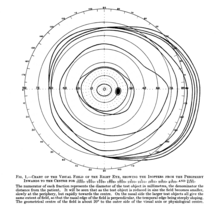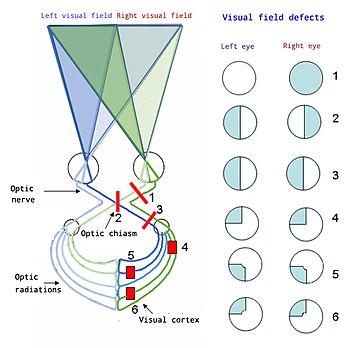Visual field
In humans and animals, the FOV refers to the area visible when eye movements – if possible for the species – are allowed.[13] The nose is situated in the field of view of both eyes, but due to later processing carried out in the brain, it is not noticed during normal visual tasks.This may be kinetic, where spots of light are shown on the white interior of a half sphere and slowly moved inwards until the observer sees them, or static, where the light spots are flashed at varying intensities at fixed locations in the sphere until detected by the subject.Another method is to use a campimeter, a small device with a flat screen designed to measure the central visual field.Another method is for the practitioner to hold up one, two, or five fingers in the four quadrants and center of a patient's visual field (with the other eye covered).Visual field loss may occur due to many disease or disorders of the eye, optic nerve, or brain.


From top to bottom:
1. Complete loss of vision in the right eye
2. Bitemporal hemianopia
3. Homonymous hemianopia
4. Quadrantanopia
5. & 6. Quadrantanopia with macular sparing
introspectionistoptical instrumentsimage sensorsfield of viewoptometryophthalmologyneurologyvisual field testscotomaloss of visionEuropean Unionmaculafoveolaperimetrycampimeteroptic nerveMacular degenerationhemianopsiaquadrantanopsiahemianopiaQuadrantanopiascotomataCentral scotomatunnel visionglaucomaretinal nerve fiber layerblind spotRetinitis pigmentosaretinametamorphopsiascotomasVisual pathway lesionsVisual systemmacular sparingvisual pathwaycentral field defectoptic chiasmabitemporal hemianopiaoptic tractoptic radiationhomonymous hemianopiaparietal lobequadrant hemianopiaCerebral palsyEpilepsyPeriventricular leukomalaciaoptic radiationscataractOptic neuritisLeber hereditary optic neuropathyMacular holeBranch retinal artery occlusionRetinal detachmentBranch retinal vein occlusionstroketraumatic brain injuryanterior ischemic optic neuropathyColobomaPapilloedemavisual cortexbitemporal hemianopsiabinasal hemianopsiahomonymous hemianopsiaHumphrey visual field analyserBiased competition theoryDivided visual field paradigmReceptive fieldPeripheral visionVisual snowMedlinePlus Encyclopedia